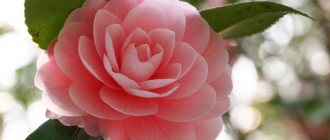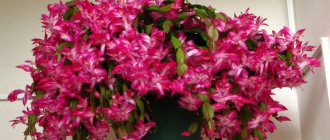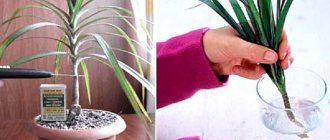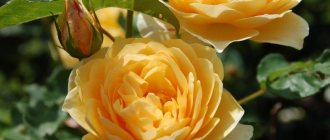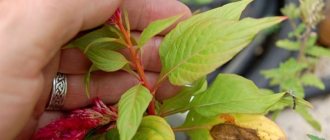Many people are familiar with a beautifully flowering indoor plant that resembles a rose. But unlike a rose, it has no thorns, and the leaves are shiny and glossy. We'll talk about camellia. The plant, which grows in countries with tropical climates, has taken its rightful place on the windowsills of our apartments and is very popular. In this article you will find useful information about growing and caring for camellias at home.
History of camellias
Today, more than 200 different types of camellias are known - all of them grow in the east. Camellia is known in Japan as Tsubaki. For many centuries, before the Westernization of Japan, the native Tsubaki, or “tree with shining leaves,” occupied a special place in Japanese thought.
In the Shinto religion, it was believed that gods in spiritual form make Tsubaki flowers their home during an earthly visit. Tsubaki plantings were an integral feature of temple gardens, cemeteries, and other places associated with the religious life of the community.
Introduction
The camellia owes its name to the naturalist Joseph Kamelius , who first introduced Europeans to this culture. In its homeland, camellia can reach gigantic sizes. Trees 5-6 m high are considered the norm in Japan. In addition, in the city of Hagi, where camellia festivals are held annually, there is a whole grove of Japanese camellia trees, about 15 m high.
Japanese camellia in natural habitats
However, it seems unlikely to obtain such sizes under our growing conditions; Usually, the trees or bushes growing here reach no more than 1.5 m in height.
Grove of camellias
Camellia is an evergreen plant with dense foliage. Traditionally, the predominant color of the leaves is dark green, often glossy. The leaf size is predominantly 6-8 cm; Most often the leaves are characterized by an oval shape, but elongated leaves up to 11 cm in length are also found.
The plant branches abundantly and usually the outermost branches act as peduncles. The buds form in the axils of the leaves.
Camellia japonica
By all accounts, the Camellia Japonica arrived in London on an East India Company ship. Tea was brought to Europe on East India Company ships from China. Officials tried to bring tea plants to England for propagation, but either by mistake or on purpose, the Chinese sent the seeds of the Camellia japonica plant instead.
By far the most important ornamental Camellia is believed to come from Japan - hence the name. The tree grows up to 30 centimeters in height. In the wild it grows as undergrowth on hillsides.
The flowers vary in size and color, usually having five to six petals and being red. They bloom in winter and have beautiful shiny evergreen leaves and an interesting brown trunk.
3.Varieties:
3.1.Japanese camellia - Camellia japonica
The most common subspecies of camellia. In its natural habitat, the plant can reach a height of 1.5 to 5 - 11 m. The leaves are glossy, green, lanceolate, the leaf blades are hard, young leaves have a burgundy-copper tint. The flowers are pink, white or red, often double, the diameter of the flowers varies from 5 to 12 cm. The flowering period begins in the spring and lasts 3 - 4 weeks.
Unfortunately, this capricious beauty is almost impossible to raise at home - it cannot stand stuffy and warm rooms.
↑ Up,
3.2.Middlebury pink camellia
a very delicate plant with large, double flowers of a soft pink hue, the main distinguishing feature of which is that the petals, gradually decreasing in size towards the center of the flower, are arranged one after another in even rows.
↑ Up,
3.3. Camellia sinensis - Camellia sinensis
Large flowering shrubs, from the upper leaves of which the familiar tea is obtained. In nature, plants can reach a height of 10 m. The leaves are green, lanceolate, glossy, and hard. The flowers are creamy-yellow, medium-sized, reaching 3-4 cm in diameter, with 7-8 rounded petals and large orange stamens.
↑ Up,
Another subspecies of Camellia sinensis is Camellia oleifera , a plant with simple white or soft pink flowers, from the fruits of which tea oil is obtained, used in cooking.
↑ Up,
The soil
When it comes to indoor care, camellias grow best in fertile, acidic, moist, well-drained soils with a high content of organic matter. In alkaline soil, plants do not thrive and may suffer from iron deficiency. If the soil is sandy, add equal parts oak leaf mold or coarse peat and fine pine bark to the pot. Camellias do not cope well with large amounts of fertilizer, so do not overuse them.
Problems during cultivation and their elimination
Frequently encountered problems when growing indoor Camellia and ways to solve them:
| Problem | Causes | Solution |
| Brown spots on leaves | Sunburn | Move the flowerpot to partial shade |
| Scanty flowering | Soil acidification, application of fertilizers with calcium and magnesium | Water the plant only with soft water, do not overwater the bush, select suitable fertilizers for feeding |
| Yellowing and falling leaves | Lack or excess of moisture, nutritional deficiencies | Regularly fertilize camellia, normalize the watering regime |
Watering
Indoor camellia flowers are susceptible to drought due to their shallow root system. Camellias need regular watering for the first three years after planting. Young plants may die if the soil is too dry.
It is necessary to water the flower and rhizome 1-2 times a week in spring, and 2-3 times in autumn. Old camellias are quite drought tolerant.
Water is not only necessary for normal growth, but also ensures the constant absorption of minerals and maximum expansion of the cells that make up the new growth.
Irregular water supply interrupts the growth process, which can lead to stunted leaves and stems.
Caring for a flower in the open ground
Nowadays, breeders have developed many varieties of garden camellia that grow well in open ground even in regions with harsh climates. But in order to achieve success in growing and see flowers on a garden plant, you need to put in a lot of effort and patience.
Soil preparation and planting
Growing camellias in the garden should begin with preparing the soil. Since garden soil is dense and does not allow water and air to pass through well, it needs to be slightly improved. To do this, make good drainage, acidify the soil and add peat, sand and compost. It is better to plant a flowering camellia in a permanent place, since at this time it is in a dormant period and, with the accumulation of strength, will tolerate transplantation much better.
How to properly transplant camellia into open ground:
- The purchased plant is carefully removed from the container, trying to preserve the earthen lump.
- When installing a plant in a hole, you need to make sure that the root collar is not too deep into the ground. But you shouldn’t leave it close to the surface of the earth, as there is a possibility that the plant will not survive the winter.
- After transplantation, the soil is compacted, watered and mulched.
- If several plants are planted, the distance between the holes should be at least 2 m.
Camellia is planted in a pre-diluted hole
Caring for garden camellia
Caring for camellia planted on a personal plot consists of timely watering, fertilizing and pruning.
Watering and fertilizing
Garden camellia is very demanding on water quality. You cannot water the shrub with tap water, as it contains a high lime content. In hot summers, the plant is watered 2-3 times a month. The first sign of a lack of moisture is the leaves drying out and falling off. In rainy summers, no watering is required.
Tree camellia is an ideal solution for landscape decoration
In the spring, during the period of active growth of young shoots, garden camellia needs to be fed twice a month. Feeding must be of high quality. Fertilizers intended for feeding azaleas are suitable for camellias.
The plant should not be overfed, as this will lead to intensive growth during the dormant period.
In the autumn, feeding is stopped, and the bushes begin to be prepared for wintering.
In regions with harsh climates, the plant is dug up and stored indoors
How to prune to form a crown
They begin to form the crown in the spring by pinching the shoots. This is necessary for better branching of the bush. In autumn, shoots are pruned to stimulate the growth of axillary buds.
With annual pruning, camellia turns into a beautiful flowering shrub.
Pruning is carried out with a sterile sharp instrument
Preparing for winter
If camellia grows in a region with harsh winters, it must be dug up and wintered in a room where the air temperature will not drop below +2°C. In regions with a mild climate, the plant is covered with breathable material.
Diseases
Camellia plants are susceptible to several pests, including aphids, mealybugs and scale, which can be controlled with insecticidal soap or systemic insecticides.
Uneven watering can cause camellia buds to drop before they open, while soil that is not acidic enough can cause the leaves to turn yellow.
Dieback disease is caused by the fungus Glomerella cingulata. Infections occur through wounds or natural openings. Dieback symptoms initially appear as small, dark, sunken areas on branches and stems.
As the canker grows, the infected stems become girdled. The stems above this belt gradually die, causing the leaves to wilt. At first, only individual branches or stems are affected. It is necessary to cut off infected branches and spray the plant with benomyl.
Botanical description
Camellias are medium-sized, evergreen, tree-like shrubs. They belong to the Tea family. Distributed in Japan, China, Korea, and the Philippines.
Camellias grow well in humid climates, in mountainous areas and are not afraid of short frosts down to -15°C.
In this case, the acceptable summer temperature should not exceed +25°C .
In other cases, it is grown as a houseplant. The leaves of the plant are simple oval in shape, strong and glossy. The flowers resemble roses or peonies. In most species, the flowers have no scent. Large, double flowers are arranged singly on the branches. Color range from white to red. An amazing feature of camellia is its long flowering period when dormant.
It begins to grow actively after flowering ends. This process begins in March - April.
Ticks
Spider mites are small and often difficult to spot on camellias. You need to place a piece of white paper or cloth under some leaves, then tap the leaves to remove the mites. They can be seen moving on white paper.
Plants infested with mites have foliage that appears dusty. If mites are present, cobwebs can be seen on the surface of the leaves.
Reproduction methods
Cameo can be propagated in two ways:
- seeds;
- cuttings.
The seed growing method is usually used by breeders, planting seeds in containers with nutrient soil, 5-7 pieces each, under film or glass. The process is quite lengthy and labor-intensive.
When propagating by cuttings, young green shoots are cut from the bush (only the tops are taken) and rooted in water or soil. When roots and new leaves appear, the cuttings are transplanted from cups into spacious containers and grown in them for 2-3 years. It’s even easier to buy ready-made seedlings at a garden center to immediately plant in a permanent place.
Root Rot
Several different fungi that infect and kill fine feeding roots cause these diseases. Root diseases are associated with plants grown in poorly drained soils.
If you do decide to try growing camellias at home, place the plant in the coolest part of the house. Places such as verandas and greenhouses.
Provide indoor-grown camellias with 8 to 10 hours of light per day.
Houseplants are susceptible to root rot. It is important that you only water the plant when the soil is just dry.
Camellias grown indoors will grow much slower than their outdoor counterparts. Fertilize every 3-4 months.
How does it reproduce
Camellia can be propagated in two ways: cuttings and seeds.
Propagation of camellia by cuttings: step-by-step instructions with photos
| Photo | Action |
| Camellia is best propagated by lignified cuttings, which are cut in mid-summer. The cutting must be at least 8 cm long and have 5 leaves. Before rooting, planting material must be treated with a root formation stimulator. | |
| The seedling is placed in prepared soil consisting of moistened sand and peat in a 1:1 ratio. Before it is buried in the soil, it must be treated with a phytohormone. This is necessary for better soil heating. | |
| For rapid rooting, the air temperature must be more than +25°C. To maintain a favorable microclimate, place a plastic bag or glass dome on the pot with the seedling. Under such conditions, the cuttings will germinate in 60 days. |
Sowing seeds
The seed propagation method is simple, effective, but time consuming. Seeds are sown in a moist substrate consisting of sand and peat, the container is covered with polyethylene and put in a warm, bright place for germination. The duration of this process depends on the conditions, and it can last from several months to a year.
As soon as the first shoots appear, the film is removed, the seedlings are watered and planted. Each plant is planted in separate pots with a volume of at least 7 cm. Camellia grown from seeds is more adapted to sudden temperature changes and grows much faster.
A plant grown from seeds begins to bloom in the 5th year.
The ripe seed pod is dark brown in color.
